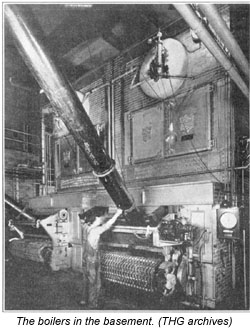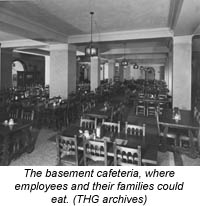Telecommunications History Group Resources
931 14th St. Historic Building
Down in the Basements - Building Tour
 Welcome to the bottom of the building, 30 feet below street level!
Welcome to the bottom of the building, 30 feet below street level!
The building has two basements: a sub-basement and a “basement proper.” The sub-basement contained a lot of equipment. It housed 48 storage batteries, which delivered current to operate the step switches and the other equipment in the building. In case of a power outage, these batteries, along with a 10,000-Watt emergency generator, would deliver power and “carry the phone system far beyond any failure ever known in this city.”*
Heating for the building was also located here, in the form of two massive boilers that extended up through the basement proper. Hot water for the building was not heated in the boilers, but instead heated by “steam coils on various floors.” This was because “there is less heat loss in the steam pipes than in water pipes.” On the opposite extreme, two very large refrigerators–3 3/4 tons and 2 tons capacity–chilled the drinking water for the building and provided ice for the lunchroom ice chests.
Finally, the “blower” furnishing the compressed air for the building’s pneumatic tube system and the fire pump were located in the sub-basement.
First Basement, or “Basement Proper”
 Called “the coolest and most alluring place in the entire building,” the main feature of the first basement was the company lunchroom. A vast cafeteria with 100 tables, its decor and color scheme were worked out by Allen True, who also did the murals that adorn the first floor of the building. The cafeteria operated 24 hours a day, seven days a week and provided food for all employees and their families. Meals cost as little as 25 cents.
Called “the coolest and most alluring place in the entire building,” the main feature of the first basement was the company lunchroom. A vast cafeteria with 100 tables, its decor and color scheme were worked out by Allen True, who also did the murals that adorn the first floor of the building. The cafeteria operated 24 hours a day, seven days a week and provided food for all employees and their families. Meals cost as little as 25 cents.
For 40 cents one could get soup, choice of meat, vegetables, choice of dessert, bread and butter, and choice of drink. On Sundays, a special 75-cent dinner included soup, meat (filet mignon or chicken), vegetables, salad, bread and butter, choice of desserts, and drinks. Before you start wishing for a time machine, however, remember: 75 cents in 1929 is equal to over $8 now, and while this is still an inexpensive steak dinner, you’d have the Great Depression to contend with a few months after the building opened. This cafeteria and its descendants operated at least through to the 1970s.
Also located in this basement were the shipping and receiving department and the cable vault, where “all the cable comes into the new building.”
*This and the other quotes on this page are from The Mountain States Monitor, September 1929.
